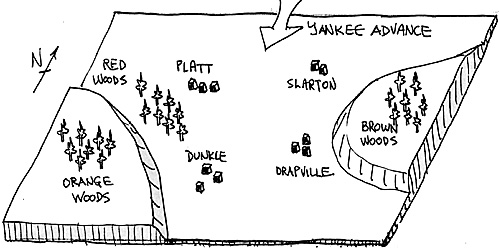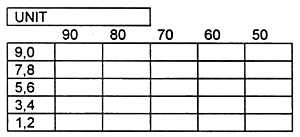In the middle of the week, with no-one around, I placed several units of my ACW 30mm collection on the table for a Yankee attack on the Confederate held positions in the Dunkle Valley.
I defined 2 stands as a regiment, a bare bones set-up needed to distinguish the formation of the units. They would either be deployed, side by side, in fighting formation, or in march column, non-fighting (one stand behind the other).
With the definition of 2 stands as a regiment, I assigned the regiments to brigades... some brigades had 4 regiments, others had 3. Eventually, I came up with 3 brigades for the Yanks, and 2 brigades for the Confederates, and termed each force a division, transforming the battle into a small corps-vs-corps encounter. During the battle, I diced to see if either side's cavalry would show up... but the mounted troopers of both sides decided to sit this one out.

I also drew up a set of data sheets for each of the regiments, which looked like this:

Each box has an X and a Y coordinate... for example, the lower right hand corner box on each unit record sheet, is identified as being in the 50 column, and the 1,2 row. Therefore, it is identified as the '51' or '52' box. Every box, therefore, is associated with a percentage dice toss above 50 The significance of the boxes is that the last 'un-crossed out' box on the data sheet is the morale level of the regiment.
You'll note that there are 25 boxes to be crossed out per regiment, and my initial thought was that, every time a regiment was hit, either in the fire phase or in melee, I'd toss the dice, and cross out the appropriate boxes. This would give me a fairly random pattern of crossed out boxes, and somehow, I'd use the 'un-crossed out' boxes as an indication of unit status as the battle progressed.
I gave up this thought around the second bound... way, way too much dice throwing. And I eventually settled for a simple 'filling in the boxes' routine... first starting with the 90 column, filling that up, then filling up the 80 column, and so on.
Again, with 25 boxes to cross out before a regiment disappeared from the field, I needed a simple way of knocking off a large number of boxes so that the game wouldn't last forever. This was accomplished with the following Hit Table, used in both firing and melee:
- 01 to 33 : 3 boxes crossed out
34 to 66 : 2
67 to 100 : 1
Add +10 to the dice throw if the target unit is in cover
What the above table indicates is that every time a unit was in combat (under fire or in melee), it had to suffer a loss of at least one box, i.e., no matter what number you throw, the target loses at least one box.
The Yanks concentrated on the western side of the field, massing for an attack on Slarton, and then Drapville. Two of the three Union brigades advanced along this line, while the remaining brigade held its own around Dunkle.
I had two methods of indicating casualties on a regiment. First, of course, was the data sheet described above, on which, as the unit took casualties in the battle, a gradual permanent degradation in the unit's ability (morale level) slowly showed itself. Second, each time a unit was hit, I placed a number of casualty figures by the unit, indicating a temporary deterioration in unit capability.
At the end of the bound, there occurred what I termed an 'administrative phase', during which the regiments diced to remove their casualty figures by tossing, with percentage dice, below the morale level shown on the sheet. If a regiment was not successful, it suffered even more losses on its data sheets... I crossed off 2 more boxes and added 2 more casualty figures to the unit.
By this two pronged method of assessing casualties, the 25-box data sheets soon filled up. A look at the fate of the Confederate 55th Tennessee Regiment illustrates this.
The 55th was assigned to do or die in Drapville, and as the Yanks approached, the Union firing units scored lots of low dice throws.
As indicated on the Hit Table shown above, low tosses are bad for the target unit, as each placed 3 hits at a blow, several times over, on the Fighting 55th. Many boxes crossed out, and many casualty figures placed with the unit.
Looking at its data sheet, the 55th's basic morale level was defined as the highest numbered box not yet crossed out... in this case, the '60' column (since the 90, 80 and 70 columns were full of hits). But it didn't end there... the reason was that every casualty figure placed on the 55th further decreased the morale level by another 5 percent. In other words, when a unit was hit, there was a 'double whammy' involved... first, it lost boxes, lowering its morale level. Second, because of the casualty figures, the morale level was lowered yet again.
The 55th's modified morale level, after accounting for its casualty figures, was somewhere down in the 40's. If it could only pass a morale test, all the casualty figures would miraculously disappear, and its basic morale level, without casualties to weigh it down, would go up to the 60 level. But the ill-fated 55th failed its morale test, i.e., didn't toss below 40. The result was that (a) it crossed off even more boxes, and (b) it received even more casualty figures.
The next time the 55th tested, the situation appeared hopeless... not enough boxes, and too many casualty figures. It fled the field, and ran off to Tennessee.
The 55th's sister units near and around Drapville were in similar dire straits. The Yanks were unstoppable.
One note on the towns on the field. Each of the 4 towns was represented by a 6-inch by 6-inch square, which was defined to hold two units. In the towns, the defending Rebels placed one regiment plus one artillery battery. Under my rules, a unit in town is fairly fluid and flexible, and I permitted both units in the town to fire out, even though there really wasn't enough room to place both units side by side in the front line.

One other item of interest on the data sheet. The above sheet is for the Wheaton Artillery. Note that I've 'Xed out' four of the boxes in the 50 column. Each X denotes that the battery fired, and these X's fill up unit's data sheet from the 'bottom up'.
I wanted some method of limiting the number of times a battery fired. I've seen too many games in which the artillery, with an unlimited supply of ammunition, becomes all-powerful, and takes over the battle. Here, as the battery takes hits, boxes 'from the top' are crossed out, and as the battery keeps firing, boxes 'from the bottom' are crossed out. And when all the boxes are crossed out, the battery limbers up and withdraws.
I played the scenario twice, in solo fashion. Each time, albeit with heavy losses, the Yankees couldn't be stopped.
Back to PW Review June 1998 Table of Contents
Back to PW Review List of Issues
Back to MagWeb Master Magazine List
© Copyright 1998 Wally Simon
This article appears in MagWeb (Magazine Web) on the Internet World Wide Web.
Other military history articles and gaming articles are available at http://www.magweb.com